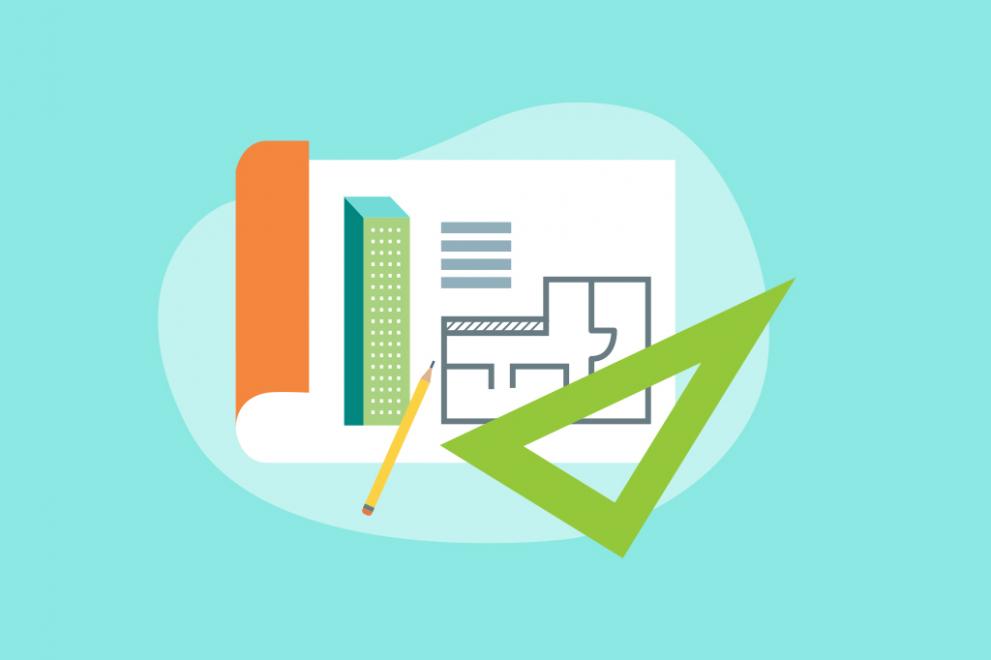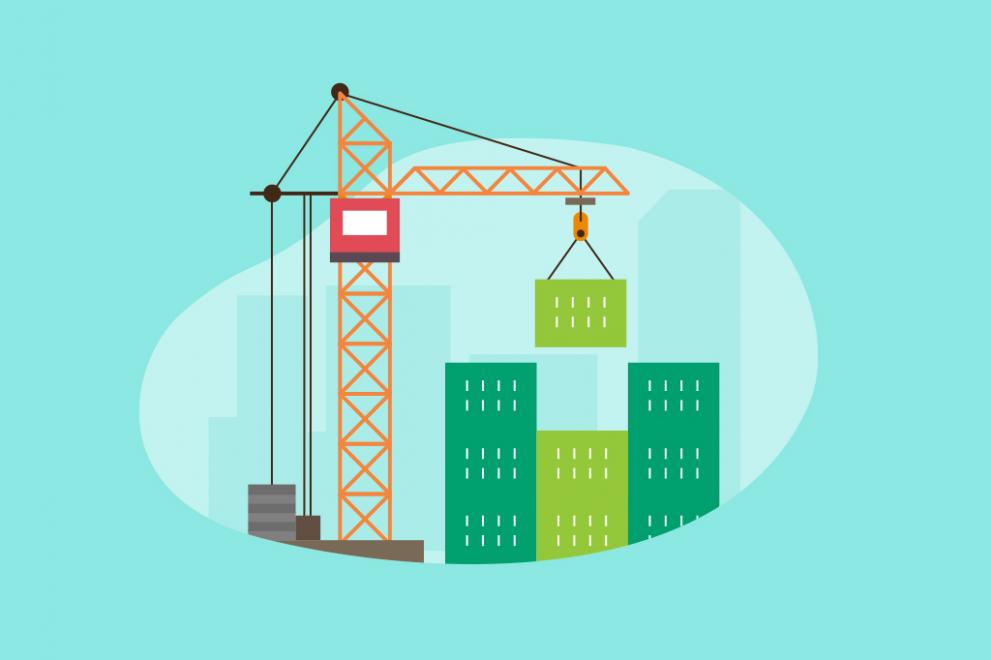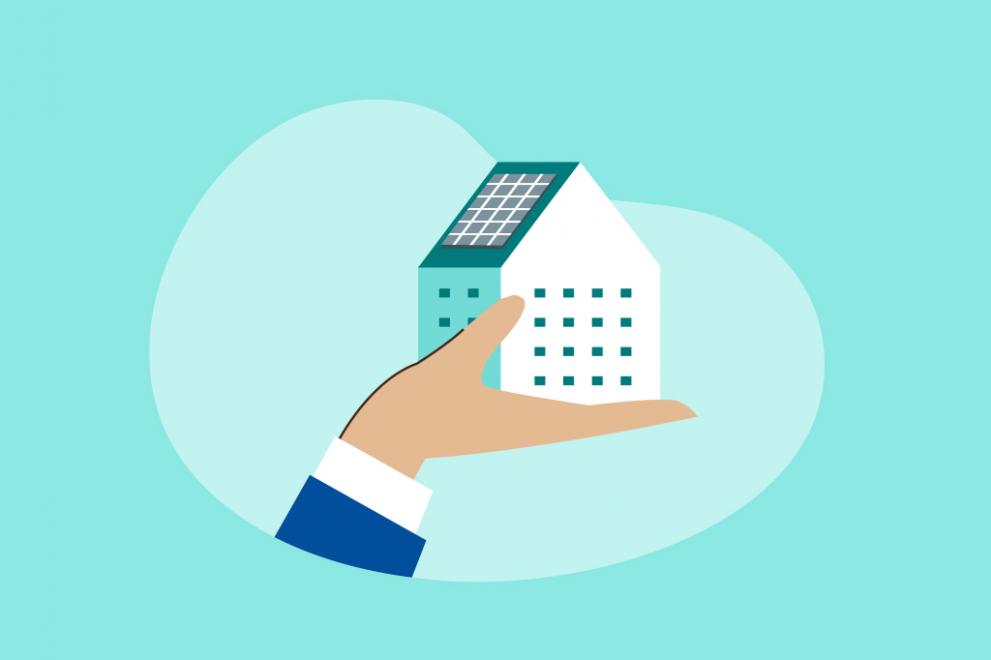A project team decides which objectives to focus on, which indicators to work with and finally, at what level. Level(s) can be applied at each stage of a building´s life cycle:
- Setting objectives at concept stage
- Assess performance at design and construction
- Follow up after completion

|
Level 1 – Conceptual design | Early stage qualitative assessments and reporting on the concepts that the chosen indicators will cover. It provides a simple structure that can be presented to clients to prioritize attention on sustainability aspects. |

|
Level 2 – Detailed design and construction | Quantitative assessment of the designed performance. Allowing comparison between different design options and monitoring of the construction according to standardized units and methods. |

|
Level 3 – As-built and in-use | Monitoring and surveying of activity both on the construction site and of the completed building and its first occupants. Level 3 helps the entire team understand actual building performance and identify lessons learned from the design to inform and improve future projects. |
Let’s apply what we know…
With an understanding of macro-objectives and indicators, we can assess each stage of the building process.
First we will apply one indicator ‘1.1 Use stage energy performance’ to each level.
| Level1. Conceptual design. | Level 2. Detailed design and construction. | Level 3. As-built and in-use. |
|---|---|---|

|

|

|
|
Qualitative assessments and reporting on the concepts This level is for those users who would like to:
This include a checklist to inform on design energy concepts. |
An intermediate level, quantitative assessment This level is for those users who are at the stage of needing to calculate the energy needs and primary energy use of a building for the purpose of design comparisons, building permitting or tendering. This could for example include an energy simulation.
|
Monitoring and surveying of activity This level is for those users who would like to:
This could include an energy meter that measures real time energy consumption. |
As you have seen, an indicator can be easily integrated into each level of the building process to provide practical guidance.
Here you can see how the remaining 15 indicators can be applied to each stage of a building´s life cycle:
Level 1. Qualitative assessments and reporting on the concepts
This Level is for those users who would like to:
- Incorporate some important life cycle concepts into design and, later, into detailed designs.
- Interpret and use the results of previously carried out life cycle GWP assessments and Life Cycle Assessments that are based on the analysis of similar building types.
This include a checklist to integrate life cycle concepts.
Level 2.An intermediate level, quantitative assessment
This Level is for those users who would like to:
• Calculate the life cycle GWP emissions of their project and select software tools and databases according to the standard EN 15978.
• Interpret and use the results from a ‘hot spot’ analysis.
Level 3. Monitoring and surveying of activity
The same procedure as defined in Level 2 but supported by the certainty of materials procured and technical building systems installed.
Level 1. Qualitative assessments and reporting on the concepts
This Level is for those users who would like to:
- Be aware of six highly relevant aspects for optimising the consumption of construction materials and products.
- Describe how these aspects were considered (or not) during discussions and decision-making at the concept design stage.
Level 2.An intermediate level, quantitative assessment
This level is for those users who would like to:
- Make an estimate of Bill of Quantities (BoQ) during the design stage that ensures that budgetary limits are respected.
- Use an inventory template to insert and manage the BoQ data. Furthermore, by entering optional cost data and lifespans, the BoQ template can generate outputs that are useful for other Level(s) indicators.
Level 3. Monitoring and surveying of activity
This level is for those users who would like to:
- Register and log BoQ data as materials and products are procured and delivered to the site based on actual quotations and purchases.
- Use an inventory template to centralize record of purchases to track spending in line with project budgets and schedules.
- Compare with estimates during design stage.
Level 1. Qualitative assessments and reporting on the concepts
This level is for those users who would like to:
- Be aware of highly relevant aspects for reducing CDW and optimising its management.
- Describe how these aspects were considered (or not) during discussions and decision-making at the concept design stage.
Level 2.An intermediate level, quantitative assessment
This level is for those users who would like to:
- Report on and to make reliable quantitative estimates of CDW.
- Use (an) inventory template(s) for CW and/or DW estimation.
Level 3. Monitoring and surveying of activity
This level is for those users who would like to:
- Measure the quantities of CDW in their project, using the Level(s) excel templates for CW and DW reporting to collate data.
Compare estimates with actual data.
Level 1. Qualitative assessments and reporting on the concepts
This level is for those users who would like to:
- Understand how the design of a building could facilitate future adaptation to changing occupier needs and market conditions.
- How these design aspects could extend the service life of the building as a whole, either by facilitating continuation of the intended use or through possible future changes in use.
Level 2.An intermediate level, quantitative assessment
This level is for those users who wish to set design targets or who are at the stage of making design decisions and wish to compare design options for their relative adaptability.
Level 3. Monitoring and surveying of activity
This level is for those users who wish to compare the final as-built design with the earlier detailed designs. It can also form the starting point for a long-term monitoring of the building and how it performs in the local property market.
Level 1. Qualitative assessments and reporting on the concepts
This level is for those users who would like to:
- Understand how the design of a building could facilitate ease of future deconstruction in order to access, disassemble and dismantle parts and materials.
- Consider the extent to which these building parts may be recovered for either reuse and/or for recycling.
Level 2.An intermediate level, quantitative assessment
This level is for those users who wish to set design targets or who are at the stage of making design decisions and wish to compare design options for their deconstruction potential.
Level 3. Monitoring and surveying of activity
This level is for those users who wish to compare the final as-built design with the earlier detailed designs. It can also form the starting point for preparing the technical content of a building passport or building material bank record.
Level 1. Qualitative assessments and reporting on the concepts
This level is for those users who would like to:
- Be aware of five highly relevant aspects for reducing and optimising use stage water consumption.
- Describe how these aspects were considered (or not) during discussions and decision-making at the concept design stage.
This include a checklist to inform on water efficient design concepts.
Level 2.An intermediate level, quantitative assessment
This level is for those users who would like to:
- Estimate the per person water consumption in the building as a function of the water consuming devices, appliances and irrigated areas via an excel-based calculator.
- Minimize potable water consumption by the specification of more efficient devices and appliances and by rainwater harvesting and/or greywater reuse.
Level 3. Monitoring and surveying of activity
This level is for those users who would like to:
- Take measures of actual water consumption over the course of one year.
- Estimate occupation rates of the building.
- Compare estimates with measures.
Level 1. Qualitative assessments and reporting on the concepts
This level is for those users who would like to:
- Be aware of three highly relevant design aspects that represent the main factors that influence IAQ and contribute to optimising the ventilation strategy for a building.
- Describe how these aspects were considered (or not) during discussions and decision-making at the concept design stage.
Level 2.An intermediate level, quantitative assessment
This level is for those users who would like to:
- Design the ventilation system, the specification of indoor fit-out materials and, in the case of major renovations, the design of insulation and other design improvements to the air tightness and integrity of the building fabric.
- Quantify the ventilation rates needed in different zones of the building.
- Factor into the design the potential influences on the quality of outdoor air (e.g. proximity of roads, traffic volume etc.) and on the quality of indoor air (e.g. emissions from materials, bio-effluents, point sources of humidity etc.).
- Inform ventilation system specifications. The difference in quality between outdoor air entering the system and the desired quality of the air to be supplied indoors will directly influence the filter specification, which in turn will influence the sizing of the system and its energy performance.
Level 3. Monitoring and surveying of activity
This level is for those users who would like to:
- Assess IAQ in an objective manner based on the performance of a completed building, two-pronged approach recommended:
- Quantitative approach based on air sampling and monitoring at two different stages: (i) after completion but prior to occupation and (ii) during occupation.
- Qualitative approach based on occupant feedback in surveys about IAQ during occupation and a remedial action plan in case of unsatisfactory results.
Level 1. Qualitative assessments and reporting on the concepts
This level is for those users who would like to:
- Assess the risks of occupier thermal discomfort during the heating and cooling seasons for the building type being assessed.
- Understand measures that can be taken to create a comfortable thermal environment in the building types being assessed.
Level 2.An intermediate level, quantitative assessment
This level is for those users who would like to:
- Assess the energy requirements of a building.
- Make a quantitative assessment of the indoor thermal conditions according to the Category II temperature ranges stipulated in EN 16978-1 (or national equivalent).
- Need to make an overheating assessment of a building for the purpose of obtaining a building permit.
Level 3. Monitoring and surveying of activity
This level is for those users who would like to:
- Collect monitoring data on the thermal conditions in a building to compare the performance with design simulations, and/or
- Carry out a post-occupancy survey of occupants to determine the level of dissatisfaction with the thermal comfort conditions and compare the results with the design estimates.
Level 1. Qualitative assessments and reporting on the concepts
This level is for those users who would like to:
- Support in understanding and prioritising the most important aspects of lighting and visual comfort to focus attention on.
- Make the right decisions when setting requirements and specifications that facilitate the later detailed design that is supportive of occupant health and comfort during visual tasks and activities.
Level 1. Qualitative assessments and reporting on the concepts
This level is for those users who would like to:
- Understand and prioritize the most important design aspects to focus attention on considering five acoustic and noise protection design aspects at the concept stage of a project.
- Make the right decisions when setting requirements and specifications. This level also provides initial suggestions for how calculations and field measurements can be made.
Level 1. Qualitative assessments and reporting on the concepts
This level is for those users who would like to:
- Assess the risks of occupier thermal discomfort during the cooling seasons for the building type being assessed.
- Understand and identify measures that can be taken to future-proof a building’s thermal environment and/or incorporate adaptation measures.
Level 2.An intermediate level, quantitative assessment
This level is for those users who are at the stage of having to assess the energy requirements of a building and wish to make a quantitative assessment of the indoor thermal conditions under projected future climate conditions.
Level 1. Qualitative assessments and reporting on the concepts
This level is for those users who would like to:
- Be aware of steps to take during the conceptual design stage (and even earlier) to ensure that the awareness of extreme weather events at the building location is maximised.
- Optimize the design of the building and any surrounding plot area for adaptation to extreme weather events.
Level 1. Qualitative assessments and reporting on the concepts
This level is for those users who would like to:
- Set out the steps to take during the conceptual design stage in order to embrace sustainable drainage options as much as possible.
- Be aware of both the risk of flooding at the building and the possible effect of the building itself on flood risk in surrounding and downstream areas.
Level 1. Qualitative assessments and reporting on the concepts
This level is for those users who would like to:
- Calculate the life cycle cost of their building project but want to understand how they can take a longer-term perspective on the costs associated with a building project.
- Incorporate some important life cycle cost concepts into conceptual designs and, later, detailed designs.
Level 2.An intermediate level, quantitative assessment
This level is for those users who would like to:
- Calculate the life cycle costs of their building project.
- Select software tools and databases.
- Understand the basic parts of the calculation and the calculation steps according to the Cost Optimal method, EN 15459 and standard ISO 15686-5, including assumptions and default parameters that shall be used and data gap filling.
Level 3. Monitoring and surveying of activity
This level is for those users who would like to:
- Revise the life cycle costs of their building project based on the as-built initial costs and any associated revisions in the projected annual and periodic costs.
- Report on the life cycle costs for a completed building.
Level 1. Qualitative assessments and reporting on the concepts
This level is for those users who would like to:
- Understand how sustainability aspects addressed by Level(s) can have an influence on property financial value and risk appraisals.
- Have a starting point for dialogue between the design team, the client and their property market specialists.
- Ensure that improved sustainability performance, which can be reported on and verified using Level(s), is amongst the factors taken into account in making a property market valuation.
Useful reading
The following publication will help you understand how the Level(s) common language framework can complement and support sustainability certification schemes for buildings in the EU.
Level(s), A common language for building assessment
